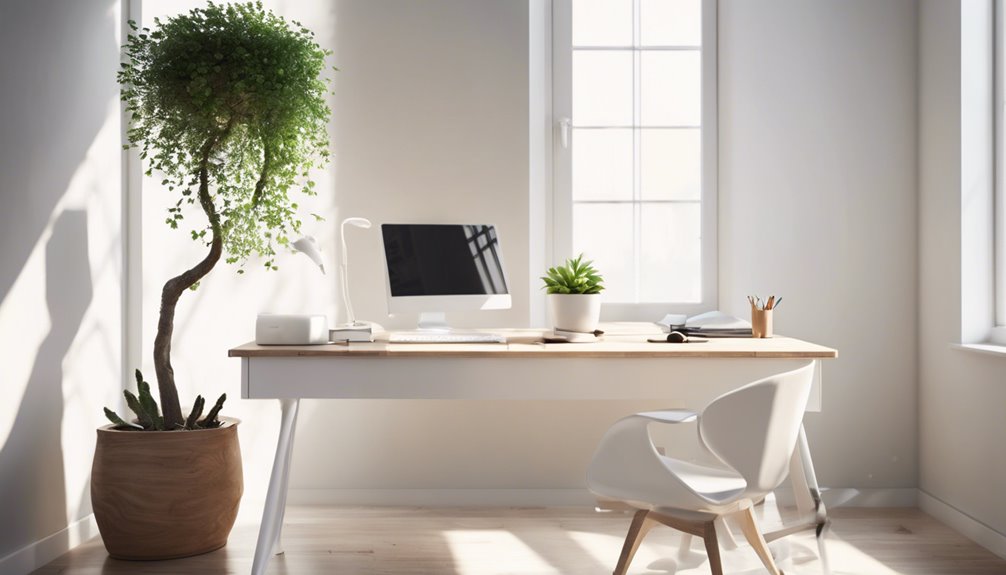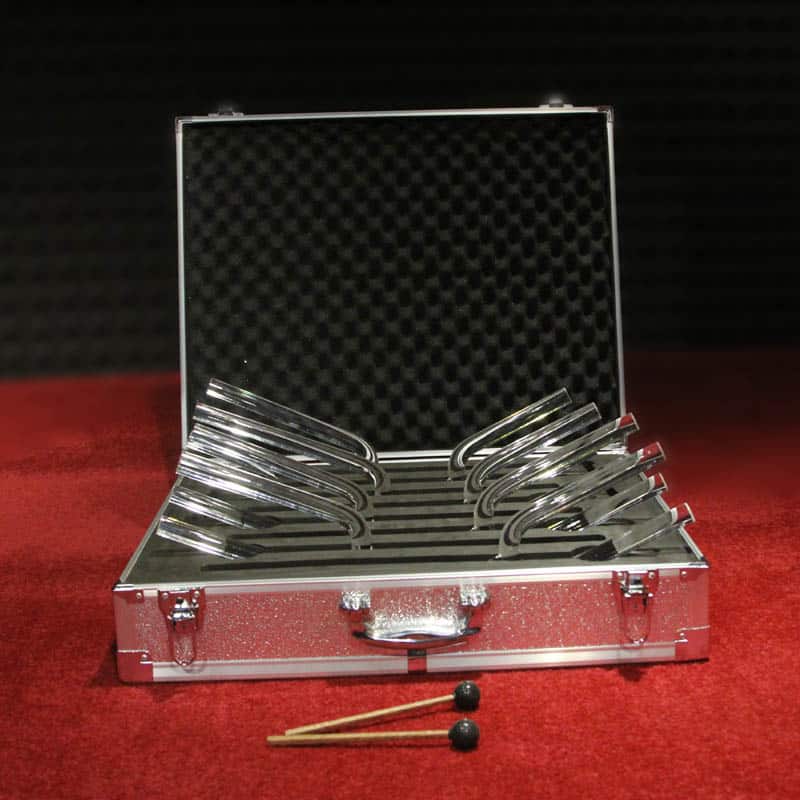You’ve likely experienced those overwhelming moments at work when your mind races, deadlines loom, and stress seems to dominate your day. While you can’t eliminate workplace pressure entirely, you can transform how you respond to it through mindfulness practices. These aren’t complex meditation routines or time-consuming exercises – they’re simple, practical techniques you can seamlessly integrate into your workday. Whether you’re dealing with back-to-back meetings, challenging colleagues, or project overload, these ten mindfulness strategies will help you maintain your calm and reclaim your focus.
Key Takeaways
�?Take strategic mini-breaks throughout workday for deep breathing exercises and gentle stretching to reset your mental state.
�?Create clear boundaries between work and personal life by establishing dedicated workspaces and consistent after-hours disconnect rituals.
�?Practice mindful transitions between tasks by pausing briefly to center yourself before starting new assignments.
�?Use grounding techniques like focusing on sensory experiences to stay present and reduce workplace anxiety.
�?Start your day with a five-minute mindful morning ritual focusing on breath awareness to set a positive tone.
Start Your Day With Breath

Take a moment before diving into your workday to establish a mindful morning ritual with conscious breathing. You’ll find that dedicating just five minutes to breath awareness can transform your entire day, creating a buffer between your personal time and work responsibilities. As you sit comfortably, focus on the natural rhythm of your inhales and exhales, allowing each breath to ground you in the present moment.
Your morning rituals don’t need to be complicated – simply observe your breath flowing in through your nose, filling your lungs, and flowing out again. When you notice your mind wandering to upcoming meetings or deadlines, gently guide your attention back to your breathing. You can enhance this practice by counting your breaths or placing your hand on your abdomen to feel the rise and fall of each breath. This simple technique will help you develop a centered mindset that you can return to throughout your workday when stress begins to mount. With consistent practice, you’ll notice improved focus, reduced anxiety, and a greater sense of control over your daily challenges.
Take Mindful Walking Breaks
When you’re feeling overwhelmed at work, taking mindful walking breaks can help you reset your mental state and reduce stress levels. As you walk, focus deliberately on each step you take, noticing how your feet connect with the ground and how your body moves through space. During your walk, you’ll find greater peace by observing the subtle details of nature around you, from the patterns of leaves to the movement of clouds, which can help shift your attention away from work-related concerns.
Walk With Purpose
Stepping away from your desk for a mindful walking break can be transformative for your mental state during the workday. When you’re feeling overwhelmed or scattered, taking intentional steps through your workplace or outside can help reset your focus and energy levels.
To walk with purpose, you’ll need to concentrate on each movement while maintaining mindful pacing. Start by noticing how your feet connect with the ground, feeling the weight transfer from heel to toe with every step. As you walk, observe your breathing pattern and try to sync it with your movement – perhaps inhaling for two steps and exhaling for three. You can also expand your awareness to include your surroundings, noting the temperature, sounds, and textures around you without getting caught up in them.
Unlike rushing from meeting to meeting, purposeful walking creates a meditation in motion that can help you process challenging emotions and clear mental blocks. You’ll often find that solutions to work-related problems emerge naturally when you’re moving with intention, allowing your mind to operate from a more centered, balanced state.
Focus On Each Step
Every mindful step you take during a work break serves as an anchor to the present moment. When you combine mindful breathing with each footfall, you’ll create a rhythmic pattern that helps quiet your racing thoughts and restore mental clarity. Focus on the physical sensations as your feet connect with the ground, noticing how your weight shifts from heel to toe with each deliberate movement.
Maintain an intentional focus on your walking experience by observing the subtle changes in your body’s motion. You’ll feel your muscles engage, your arms swing naturally, and your posture adjust as you move forward. If your mind begins to wander back to work-related concerns, gently guide your attention to the simple act of walking. Notice how your breathing naturally synchronizes with your steps, creating a harmonious flow that helps dissolve tension and anxiety. This practice of focusing on each step transforms a simple walk into a powerful stress-management tool, allowing you to return to your desk feeling more centered, refreshed, and ready to tackle the challenges ahead.
Notice Nature’s Details
During mindful walking breaks, the natural world offers countless details that can anchor your attention and deepen your mindfulness practice. When you step outside, you’ll discover an endless array of nature sounds that can help reset your stressed mind, from rustling leaves to birdsong. Take time to notice the subtle seasonal changes happening around your workplace, like emerging buds in spring or the first hints of autumn colors.
You can enhance your outdoor mindfulness with simple observation exercises that bring you fully into the present moment. Focus on a single tree and notice how its branches move in the wind, or watch how shadows shift across the ground as clouds pass overhead. If you have access to outdoor spaces at work, consider incorporating mindful gardening into your breaks – even tending to a small container garden can help ground you in the natural world. As you touch the soil and tend to plants, you’re creating a connection that pulls your attention away from workplace stress. These moments of natural observation can serve as powerful reset buttons throughout your workday, helping you return to your tasks with renewed focus and clarity.
Practice Desktop Meditation

Finding moments of calm at your desk doesn’t require special equipment or a meditation room. Your desktop environment already contains everything you need to practice mindfulness during your workday. By transforming ordinary objects into meditation tools, you’ll discover opportunities for peaceful reflection right where you sit.
Begin by sitting comfortably in your chair, planting both feet firmly on the floor. You can focus on your computer screen’s steady glow, using it as an anchor point for your attention, or close your eyes if you prefer. Take three deep breaths, letting your shoulders relax with each exhale. When thoughts about deadlines or meetings arise, acknowledge them without judgment and return your focus to your breathing. You can even use common office sounds, like keyboard clicking or distant conversations, as meditation focal points rather than viewing them as distractions.
Try setting a timer for just three minutes initially, gradually increasing the duration as you become more comfortable. This practice helps reset your nervous system, improve concentration, and reduce workplace anxiety without disrupting your workflow or requiring additional resources.
Create Mindful Transitions
Building mindful shifts into your workday can help you stay centered and focused as you move between different tasks and responsibilities. You’ll find greater peace of mind by taking short breaks to consciously pause, stretch, or breathe deeply between meetings or major projects, allowing your mind to reset before tackling the next challenge. Creating clear boundaries between work and home life, such as developing specific end-of-day rituals or turning off work notifications after hours, will help you maintain a healthier relationship with your professional responsibilities while protecting your personal time.
Take Mindful Mini-Breaks
Throughout your workday, brief mindful breaks can create essential breathing room between tasks and meetings. When you’re feeling overwhelmed, take a few minutes to practice mindful breathing by focusing on each inhale and exhale, allowing tension to dissolve with every breath. You’ll find that these short pauses help reset your mental state and improve your ability to concentrate on upcoming challenges.
Consider incorporating stress journaling during these mini-breaks, which lets you document your thoughts and feelings in real-time. By writing down what’s causing your stress, you’ll gain clarity about your emotional triggers and develop better coping strategies. Even five minutes of journaling can help you process difficult situations and maintain perspective throughout your day.
To make the most of your mindful breaks, find a quiet space where you won’t be interrupted, set a gentle timer, and give yourself permission to temporarily disconnect from work demands. You might sit in your car, use an empty conference room, or step outside for fresh air. These intentional pauses aren’t just breaks from work—they’re investments in your mental well-being and professional performance.
Set Work-Home Boundaries
Clear boundaries between work and home life serve as essential anchors for maintaining mindfulness and reducing stress. When you’re working from a home office, it’s imperative to implement effective time management strategies that protect your personal time while maintaining productivity. Creating designated workspaces and practicing clear communication with family members about your work schedule helps establish these essential boundaries.
To achieve a healthy work-life balance through mindful boundary setting, you’ll want to:
- Create a dedicated workspace that’s separate from your living areas, allowing you to mentally shift between work and home modes
- Set specific work hours and communicate them clearly to both colleagues and family members to prevent work from bleeding into personal time
- Establish an after-hours disconnect ritual, such as shutting down your computer and putting away work materials at a consistent time
- Practice family involvement by discussing and agreeing on boundaries together, ensuring everyone understands and respects your work schedule
These deliberate separations between professional and personal life will help you maintain focus during work hours while protecting your ability to fully recharge during downtime.
Pause Before Responding
When faced with stressful work situations, taking a deliberate pause before responding can prevent impulsive reactions and reduce anxiety. You’ll demonstrate higher emotional intelligence by creating space between triggers and your responses, allowing time to process information and craft constructive feedback appropriately.
Before you react to challenging workplace scenarios, consider using this response framework:
| Pause Type | Duration | Purpose |
|---|---|---|
| Quick Break | 10-30 seconds | Take deep breaths and collect thoughts |
| Mini Reset | 2-5 minutes | Walk away and regain composure |
| Think Time | 10-15 minutes | Analyze situation thoroughly |
| Extended Pause | 1-2 hours | Draft and review response |
| Overnight Rest | 24 hours | Process complex situations |
You’ll find that pausing allows you to evaluate situations from multiple perspectives and respond rather than react. When you’re triggered by a colleague’s comment or a challenging email, step back and ask yourself what information you might be missing. Taking this mindful approach helps maintain professional relationships and creates a more positive work environment where thoughtful communication prevails over emotional outbursts.
Set Digital Boundaries
Your digital devices can become major sources of work stress, but you’ll find relief by establishing clear boundaries around their use. You can start by turning off non-essential phone notifications and setting specific times to check email, which prevents the constant interruption of your focus and workflow. Creating designated tech-free zones in your workspace or home, such as your desk during deep work sessions or your bedroom at night, will help you maintain a healthier relationship with technology and reduce work-related anxiety.
Turn Off Phone Notifications
Digital distractions can derail your focus and amplify workplace stress throughout the day. When you’re constantly bombarded by notification overload, it’s nearly impossible to maintain the deep concentration needed for meaningful work. By implementing strategic focus techniques and taking control of your notifications, you’ll create a more productive and peaceful work environment.
To effectively manage your phone notifications and reduce workplace stress, consider these essential steps:
- Schedule specific times to check your phone, ideally during natural breaks in your workday, rather than responding to every buzz and ding
- Customize your notification settings by disabling alerts for non-essential apps and keeping only vital communications active
- Use your phone’s “Do Not Disturb” or “Focus Mode” features during designated deep work periods to maintain uninterrupted concentration
- Create notification-free zones in your workspace by keeping your phone face-down or in a drawer when you need to concentrate on important tasks
Schedule Email Checking Times
Although email is essential for modern work communication, constantly monitoring your inbox can greatly increase stress levels and fragment productivity. You’ll find yourself jumping between tasks, losing focus, and experiencing heightened anxiety every time a new message arrives.
To implement effective email frequency management, you’ll need to establish designated checking times throughout your day. Start by selecting 2-3 specific time slots, such as early morning, after lunch, and late afternoon, when you’ll dedicate focused attention to your inbox. During these periods, process emails thoroughly by responding, archiving, or scheduling follow-up actions. Outside of these designated times, close your email application completely to support digital distraction reduction.
Let your colleagues know about your new email schedule, which will help set expectations for response times. You can create an auto-responder that politely informs senders when they can expect to hear back from you. This structured approach not only reduces stress but also increases your productivity by allowing for deeper concentration during non-email work periods. Remember, most emails aren’t truly urgent and can wait for your next scheduled checking time.
Create Tech-Free Zones
In today’s hyperconnected workplace, establishing tech-free zones can create essential mental breathing room and reduce chronic stress. By designating specific areas where technology isn’t allowed, you’ll enhance your tech free mindfulness and discover opportunities for deeper focus and reflection.
To create effective tech-free zones that support distraction free productivity, consider implementing these proven strategies:
- Transform your lunch area into a device-free sanctuary where you can eat mindfully, connect with colleagues face-to-face, and give your mind a genuine digital detox
- Designate your bedroom as a no-tech zone at least one hour before bedtime, allowing your brain to wind down naturally without blue light interference
- Convert meeting spaces into phone-free environments where participants must check their devices at the door, enabling more meaningful discussions and creative problem-solving
- Set up a quiet corner in your workspace specifically for tech-free breaks, complete with comfortable seating and perhaps some inspiring reading materials
Remember that these boundaries aren’t about completely disconnecting from technology, but rather about creating intentional spaces where you can practice presence and restore your mental energy throughout the day.
Ground Yourself Through Your Senses

When stress threatens to overwhelm you at work, using your five senses can quickly bring you back to the present moment. Through simple grounding exercises, you’ll discover how engaging your senses can create a calming sanctuary right at your desk.
Start by incorporating visual distractions that soothe your mind, such as photos of serene landscapes or ambient lighting that creates a peaceful atmosphere. You can enhance your workspace with scented candles or essential oils, choosing fragrances that promote focus and relaxation. Keep textured objects within reach for tactile mindfulness – a smooth stone or stress ball can provide comfort through touch. Nature sounds or harmonious music playing softly through headphones can mask disruptive office noise while promoting concentration.
Don’t forget the power of mindful eating during breaks. Instead of rushing through meals, practice sensory meditation by fully experiencing your food’s flavors and textures. These grounding techniques work together to create a multi-sensory approach to stress management, helping you maintain balance throughout your workday. By actively engaging your senses, you’re building a stronger connection to the present moment and reducing work-related anxiety.
Schedule Worry Time
While grounding techniques help manage stress in the moment, scheduling dedicated worry time can prevent anxious thoughts from consuming your entire workday. By setting aside 15-20 minutes each day to address your concerns, you’ll create a structured approach to managing work-related anxiety. You can use a worry journal for your daily reflections, which helps contain racing thoughts and prevents them from interfering with your productivity.
To make the most of your scheduled worry time, follow these steps:
- Choose a consistent time each day, preferably not too close to bedtime, when you won’t be interrupted
- Write down every concern that’s been bothering you, including both rational and irrational worries
- Review each worry objectively and brainstorm potential solutions or action steps
- Close your worry journal when the time is up, symbolically containing your concerns until the next session
When worries arise during work hours, simply jot them down briefly and promise yourself you’ll address them during your designated worry time. This practice helps you stay focused on your tasks while acknowledging that your concerns deserve attention at the right moment.
Find Your Anchor Moments

Throughout your workday, anchor moments serve as mindful pauses that help you reset and regain focus when stress begins to mount. These strategic breaks, when practiced consistently, can transform your daily routine into a more balanced and centered experience, allowing you to navigate workplace challenges with greater clarity and composure.
To establish effective anchor activities, you’ll want to identify specific triggers or times during your day that can serve as mindful reminders. You might choose to pause and take three deep breaths every time you receive a notification, or perhaps practice a moment of mindfulness whenever you shift between tasks. Common anchor moments include drinking your morning coffee, walking to meetings, or logging into your computer. The key is to select activities you already perform regularly and infuse them with intentional awareness. As you develop this practice, you’ll find these brief moments of mindfulness becoming natural reference points throughout your day, creating a rhythm that helps maintain your emotional equilibrium and mental sharpness when work pressures intensify.
Release Tension Through Movement
Physical movement is one of the most effective ways to break free from work-related tension and stress. When you’re feeling overwhelmed at your desk, incorporating simple movement activities can help release both mental and physical strain that builds up throughout your workday. You’ll find that even brief periods of purposeful movement can transform your energy levels and reduce the impact of workplace pressure.
To maximize tension release through movement, try these proven strategies during your workday:
- Stand up every hour and perform gentle shoulder rolls, neck stretches, and arm circles for at least two minutes
- Take short walking breaks around your office or building, focusing on deep breaths and conscious steps
- Practice desk yoga poses that target common problem areas like wrists, back, and hips
- Set reminders to do quick tension-release exercises, such as clenching and releasing your muscles from head to toe
Remember that movement doesn’t need to be intense or time-consuming to be effective. You’ll notice that consistent, mindful movement throughout your day can greatly reduce stress while improving your focus and overall well-being.
Conclusion
While you’re busy mastering these mindfulness techniques to reduce your work stress, you’ll ironically discover that the very moments you thought you couldn’t spare become your most valuable assets. As you integrate these practices into your daily routine, you’ll realize that taking time to pause isn’t just a luxury – it’s the essential foundation for sustainable productivity and mental clarity. Your future self will thank you for starting today.







